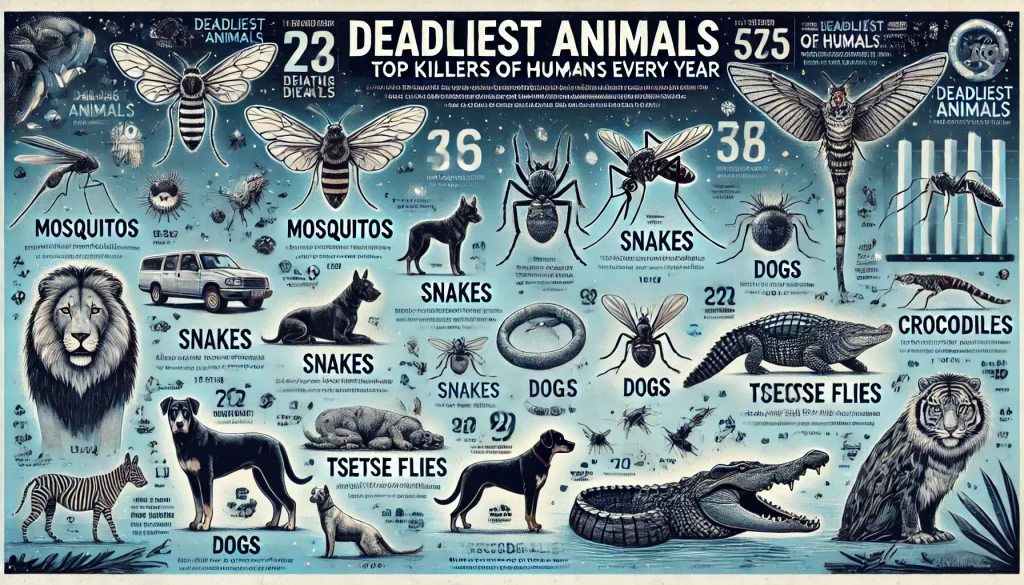Top 10 Deadliest Animals That Kill Humans Every Year

When we think of dangerous animals, our minds often drift to fearsome predators like sharks or lions. However, the animals most dangerous to humans are often surprising and, in many cases, much smaller than you’d expect. This article explores the top 10 Deadliest animals that kill humans every year, emphasizing the importance of awareness and safety measures.
Table of Contents
1. Mosquitoes
At the top of the list is the mosquito, responsible for more human deaths annually than any other animal. These tiny insects may seem insignificant, but they are vectors for some of the deadliest diseases on the planet. According to the World Health Organization (WHO), mosquitoes are responsible for the deaths of over 700,000 people each year due to diseases like malaria, dengue fever, Zika virus, and yellow fever. Malaria alone accounts for approximately 400,000 deaths annually, most of which are in sub-Saharan Africa.
Why Are They So Deadly?
Mosquitoes transmit pathogens when they feed on human blood. The diseases they carry are particularly lethal in regions with limited access to healthcare and preventive measures, making them a significant global health challenge. While efforts to combat mosquito-borne diseases are ongoing, these tiny killers remain a formidable threat to human life.
2. Humans (Homo sapiens)
Surprisingly, humans themselves are one of the leading causes of human deaths. According to the United Nations Office on Drugs and Crime (UNODC), an estimated 464,000 people are killed each year as a result of intentional homicide. This figure does not include deaths caused by war, terrorism, or other forms of organized violence, which could significantly increase the total number of deaths caused by humans.
The Dark Side of Humanity
The reasons behind these killings are varied, ranging from personal disputes and domestic violence to organized crime and political conflict. Despite advances in law enforcement and social programs aimed at reducing violence, human-on-human violence remains a pervasive problem worldwide.
3. Snakes
Snakes are responsible for approximately 81,000 to 138,000 deaths annually, according to the WHO. Venomous snakebites are a significant health concern, particularly in rural areas of Africa, Asia, and Latin America. Many victims are agricultural workers, children, and individuals living in poverty who lack access to effective antivenom treatment.
Venomous Threats
Not all snakes are dangerous, but species like the Indian cobra, Russell’s viper, and the black mamba are particularly lethal. The toxins in their venom can cause paralysis, internal bleeding, and organ failure if not treated promptly. Access to antivenom is critical, but in many regions, it is either unavailable or too expensive, leading to a high mortality rate from snakebites.
4. Dogs (Canis lupus familiaris)
Man’s best friend can also be a deadly threat, responsible for approximately 25,000 to 35,000 deaths annually. The majority of these deaths are due to rabies, a viral disease transmitted through the bite of an infected dog. Rabies is almost always fatal once symptoms appear, but it is preventable with prompt medical treatment following a bite.
The Rabies Risk
Rabies remains a significant public health issue in many parts of Asia and Africa, where vaccination programs for dogs are not widespread. Public health initiatives aimed at increasing vaccination rates in dogs and educating people about the risks of rabies are essential to reducing the number of deaths caused by dog bites.
5. Tsetse Flies
Tsetse flies, native to sub-Saharan Africa, are responsible for the spread of trypanosomiasis, commonly known as sleeping sickness. This disease affects both humans and animals and, if left untreated, is usually fatal. According to the WHO, there are around 10,000 cases of sleeping sickness reported annually, but the actual number of cases is likely higher due to underreporting in remote areas.
The Silent Killers
Tsetse flies are particularly dangerous because the initial symptoms of sleeping sickness are mild and often go unnoticed. As the disease progresses, it affects the central nervous system, leading to severe neurological symptoms and, eventually, death. Control measures, such as trapping flies and treating infected individuals, have reduced the incidence of sleeping sickness, but the risk remains significant.
6. Assassin Bugs (Kissing Bugs)
Assassin bugs, also known as kissing bugs, are carriers of Chagas disease, a potentially deadly illness that affects millions of people in Latin America. The bugs transmit the disease when they bite and defecate near the wound, allowing the parasite Trypanosoma cruzi to enter the bloodstream. According to the WHO, Chagas disease causes around 10,000 deaths annually.
A Growing Threat
Chagas disease can lead to severe heart and digestive system complications if left untreated. The disease often goes undiagnosed for years, making it difficult to treat effectively. Although progress has been made in controlling the spread of Chagas disease, it remains a serious public health concern in many rural areas of Latin America.
7. Freshwater Snails
Freshwater snails are responsible for transmitting schistosomiasis, a parasitic disease that affects millions of people worldwide. According to the WHO, schistosomiasis causes an estimated 200,000 deaths annually, primarily in Africa. The disease is spread when people come into contact with freshwater sources contaminated with the parasite.
A Hidden Danger
The symptoms of schistosomiasis vary but can include abdominal pain, diarrhea, and blood in the urine or stool. Chronic infection can lead to liver damage, kidney failure, and bladder cancer. Efforts to control the spread of schistosomiasis focus on improving access to clean water, sanitation, and preventive treatment in high-risk areas.
8. Crocodiles
Crocodiles are among the deadliest large animals on the planet, responsible for approximately 1,000 deaths annually. These powerful predators are found in Africa, Asia, the Americas, and Australia, with the Nile crocodile being particularly notorious for its attacks on humans.
The Apex Predator
Crocodiles are ambush predators, using their stealth and strength to overpower their prey, including humans. Most attacks occur near water sources where people gather for activities like fishing, bathing, or collecting water. The unpredictable nature of crocodile attacks makes them particularly dangerous, and the likelihood of survival is low once an attack begins.
9. Hippopotamuses
Despite their herbivorous diet, hippos are highly aggressive and territorial, leading to an estimated 500 deaths per year. These large mammals are found in sub-Saharan Africa, where they inhabit rivers, lakes, and swamps. Hippos are known to charge at boats and humans who come too close, using their massive jaws and sharp teeth as weapons.
The Unexpected Killer
Hippos are responsible for more human deaths in Africa than most other large animals, including lions and elephants. Their speed on land and in water, combined with their aggressive nature, makes them a significant threat to anyone who ventures too close to their territory.
10. Elephants
Elephants, the largest land animals, are responsible for around 500 deaths annually. These majestic creatures can become highly aggressive, especially when they feel threatened or provoked. Human-elephant conflict is common in areas where human settlements encroach on elephant habitats, leading to deadly encounters.
The Gentle Giants Turned Deadly
While elephants are generally peaceful, they can cause significant destruction when they charge, using their massive size and strength to trample or gore their victims. Efforts to reduce human-elephant conflict focus on habitat conservation and community education to minimize the risk of deadly encounters.
Conclusion
The animals responsible for the most human deaths each year are not always the ones we fear the most. From tiny insects like mosquitoes to large mammals like elephants, these creatures remind us of the delicate balance between humans and nature. Awareness, education, and preventive measures are key to reducing the number of deaths caused by these deadly animals.
While the numbers are alarming, many of these deaths are preventable with the right interventions, such as vaccination programs, access to medical care, and public health campaigns. By understanding the risks and taking appropriate precautions, we can coexist more safely with the world’s deadliest animals.
References
- World Health Organization. (2022). Mosquito-borne diseases. Retrieved from WHO.
- United Nations Office on Drugs and Crime. (2020). Global study on homicide. Retrieved from UNODC.
- World Health Organization. (2020). Snakebite envenoming. Retrieved from WHO.
- World Health Organization. (2020). Rabies. Retrieved from WHO.
- World Health Organization. (2020). Schistosomiasis. Retrieved from WHO.
- Centers for Disease Control and Prevention. (2020). Chagas disease. Retrieved from CDC.
- World Health Organization. (2020). Trypanosomiasis, human African (sleeping sickness). Retrieved from WHO.
This article is crafted with SEO best practices in mind, ensuring that it ranks well in search engines and reaches a broad


